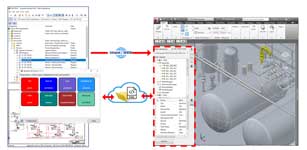Systems Engineering | Basics and expert knowledge
- Details
- Hits: 2107
This interdisciplinary area Systems Engineering brings together diverse disciplines and practices and focuses on the development, integration and management of complex systems in various industries. In this post we invite you to find out about the latest Software innovationsn to inform and the Basics to get to know systems engineering: from the definition and purpose to the core disciplines, human factors and risk management.

Contents
- Key Findings
- Building blocks for systems engineering
- Understanding Systems Engineering: Definition and Purpose
- Development of systems engineering
- Core processes in systems engineering
- Integration of human systems and socio-economic context
- Advanced Systems Engineering
- Competencies and skills for systems engineers
- Frequently asked questions
Key Findings
Systems engineering is a interdisciplinaryit is a field that uses various disciplines and practices to develop, integrate and manage complex systems. Systems engineers are responsible for designing, implementing, and maintaining systems that meet the needs of all stakeholders. Advanced systems engineering requires companies to use innovative technologies and techniques to remain competitive. If you would like to learn more about systems engineering, read on:
Building blocks for systems engineering
Systems engineering takes into account both technical and non-technical aspects and ensures that the system meets the customer or user's requirements while being reliable, safe and effective. Systems engineering combines various disciplines and tools to design, develop and optimize complex systems. It takes into account both hardware and software components as well as human factors, processes and documentation to ensure an efficient and effective system.
The Main building blocks of systems engineering can be divided into the following categories:
- Software:
- Modeling tools help create system models that represent the functions and behavior of the system. Examples are SysML (System Modeling Language) and UML (Unified Modeling Language).
- Simulation software enables system models to be checked and analyzed in terms of their performance and reliability.
- Requirements management tools support the collection, management and review of system requirements.
- Hardware:
- Prototype Hardware: When developing physical systems, prototypes can be used to test and verify the design.
- Embedded Systems: Many systems contain embedded control systems or microcontrollers.
- Sensors and actuators can be used to collect data from the environment or to perform physical actions.
- Methods & processes:
- Requirements analysis takes care of defining and managing the requirements for the system.
- Design and Architecture: Creating a detailed design of the system.
- Integration and testing: ensure that all components of the system work together correctly.
- Validation and verification are used to check whether the system meets the specified requirements.
- System optimization includes processes that improve system performance, reliability and efficiency.
- Human factors:
- User interface design to design interfaces that are user-friendly and efficient.
- Ergonomics and safety considerations to ensure the system is safe to use and meets user requirements.
- Documentation:
- Technical manuals with instructions for installing, operating and maintaining the system.
- System documentation with detailed descriptions of system design, architecture and components.
Classic example of systems engineering
A classic example of systems engineering is the development of a modern passenger aircraft. It shows the complexity and the holistic approach that systems technology takes. It's not just about developing a technically functioning product, but rather creating a system that functions optimally in all aspects - from safety to economic efficiency to user-friendliness. Here are the individual aspects of the big picture:
- complexity: A passenger aircraft is made up of millions of individual parts, from tiny screws to large turbine blades. Each of these parts has a specific function and must harmonize with other parts.
- Interdisciplinary approach: Experts from different disciplines are involved in the development - from aerodynamicists, automation technology, mechanical engineers, electrical engineers, software developers to ergonomics experts and materials scientists.
- requirements management: The aircraft must meet numerous requirements, from safety to fuel economy to passenger comfort and economy.
- Integration: All systems – from the navigation system to the cabin lighting to the engine – must be seamlessly integrated so that they work together smoothly.
- Testing and Validation: Before entering service, the aircraft undergoes intensive testing to ensure that all components function as expected and are safe.
- Lifecycle management: An aircraft is operated for several decades. Systems technology not only looks at the development and production, but also the operation, maintenance and ultimately the decommissioning of the aircraft.
- Stakeholder management: Many stakeholders are involved in the development of an aircraft - from airlines to regulators to passengers. The needs and concerns of all stakeholders must be taken into account.
Below we present new developments from companies for all building blocks:
Platform for a holistic, real-time view of all processes
 05.10.2023/XNUMX/XNUMX | the 3Dexperience-Platform from Dassault Systèmes paves the way for innovative design and development processes. As a holistic solution, it integrates a wide range of tools in a central environment. Discover how the Gamechangerplatform creates a networked, collaborative work environment.
05.10.2023/XNUMX/XNUMX | the 3Dexperience-Platform from Dassault Systèmes paves the way for innovative design and development processes. As a holistic solution, it integrates a wide range of tools in a central environment. Discover how the Gamechangerplatform creates a networked, collaborative work environment.
Interdisciplinary configuration in order processing
 March 15.03.2023, XNUMX | Mechanical engineering companies and suppliers need consistent solutions when digitizing their strategies and processes CAD data in the product configuration. Products that are increasingly in demand for individual products also make their standardization and modularization necessary. Cideon Conify has the right solution for this.
March 15.03.2023, XNUMX | Mechanical engineering companies and suppliers need consistent solutions when digitizing their strategies and processes CAD data in the product configuration. Products that are increasingly in demand for individual products also make their standardization and modularization necessary. Cideon Conify has the right solution for this.
Aucotec opens gate 3 to the 3rd dimension in Engineering Base
 09.09.2020 | Aucotec standardizes the link between 3D and 2D with its new 3D portal Engineering in mechanical and plant engineering. Web-based or client-independent data exchange can now be carried out between all common 3D applications and the collaboration platform Engineering base (EB).
09.09.2020 | Aucotec standardizes the link between 3D and 2D with its new 3D portal Engineering in mechanical and plant engineering. Web-based or client-independent data exchange can now be carried out between all common 3D applications and the collaboration platform Engineering base (EB).
Efficient engineering for the digitization of the value chain
November 20.11.2019, XNUMX | The path to industrialization and thus to more efficient product development takes three central steps: digitalization, standardization and automation. EPLAN offers digital solutions for this value chain, based on standardized data and automated processes.
Integrated tools and services for digital engineering
 05.11.2019/XNUMX/XNUMX | the digital transformation lives from the closer connection of the available data - not only in the current production, but already in the development of machines and systems. Lenze shows which data the company makes available to its partners and how it can be integrated and used advantageously.
05.11.2019/XNUMX/XNUMX | the digital transformation lives from the closer connection of the available data - not only in the current production, but already in the development of machines and systems. Lenze shows which data the company makes available to its partners and how it can be integrated and used advantageously.
Understanding Systems Engineering: Definition and Purpose
Systems engineering deals with design, integration and management complex systems throughout their entire life cycle. It draws on a body of knowledge that encompasses various disciplines and practices. One of the key aspects is the implementation of activities that lead to the successful development and management of these complex systems.
According to NASA Systems Engineering pursues the following goals:
- Consistent with stakeholder requirements for functional, physical and operational performance throughout the intended operational environment and planned life of the system
- Compliance with costs, schedule and other requirements
- Comprehensive understanding of complex systems and emphasizing systems thinking
- Focusing on optimizing each component within the system to fulfill its intended function.
Complex systems and systems thinking
A complex system consists of numerous components interact with each other, such as hardware, software and other subsystems. They all work together to achieve a set goal. Systems thinking helps engineers recognize the interdependencies and interactions within the system and take a comprehensive view.
Feedback loops influence the behavior of the system. The development of these systems is a crucial aspect of systems engineering, including production systems. The understanding of the System structure plays an important role in the effective management of these interactions. Cognitive Systems Engineering works as a method for analyzing and designing these complex systems and forms the basis of system development.
The role of the systems engineer
The job of a systems engineer is to evaluate and harmonize the contributions of different disciplines. His goal is one uniform result, which is not heavily influenced by any particular discipline. Systems engineers are responsible for implementing and maintaining IT systems that include hardware, software, equipment, facilities, personnel, processes and procedures.
The role of systems engineers is to manage and combine multiple disciplines to ensure the effective development and operation of a system. They must ensure that complex systems function as intended and meet the needs of stakeholders.
Development of systems engineering
The term systems engineering first appeared in the 1940s at Bell Telephone Laboratories, where the concepts of systems engineering were developed. Since then, the engineering discipline has evolved, also with the help of standardization and guidelines developed by organizations such as Incose, GfSE, ISO or VDI.
These organizations provide guidelines for various types of integrated systems to ensure their effective development, integration and management.
The primary processes of systems engineering, including systems analysis, requirements elicitation and model-based systems engineering (MBSE), are closely related to the Project management. These processes include planning, executing and controlling the development of complex systems.
Early developments and contributions
Early contributions to systems engineering include the development of concepts and practices at Bell Labs and the groundbreaking techniques and methods developed by engineers at the NASA and the MIT were developed and formed the basis for the discipline of systems engineering. These techniques, such as systems analysis, systems design, systems integration and systems engineering management, have been widely adopted and have contributed to the advances in systems engineering.
The impact of these early developments on the field was significant, as they provided a framework for developing complex systems and enabled engineers to design systems that met customer requirements.
Standardization and guidelines
Standards such as ISO/IEC/IEEE 15288, ANSI/EIA-632, ISO/IEC 26702 (formerly IEEE 1220), MIL-STD 499 Series (US military standard), IEC 62278 (formerly IEC 15288) and ISO 29148 are related to systems engineering applicable and offer a uniform framework for process descriptions in the life cycle of systems. They describe the processes and terminology of the system life cycle from a technical perspective. That is also useful Incose Systems Engineering Handbook. While it is not a formal standard, it is published by the International Council on Systems Engineering (Incose) and provides detailed guidance on best practices in systems engineering.
The aim of all these standards and guidelines is to ensure uniformity and excellence in systems engineering practices, with compliance with the standards enabling improved quality, greater efficiency and reduced costs. However, challenges associated with applying the standards include the need for training and the complexity of adapting to changing requirements.
Core processes in systems engineering
 The core processes of systems engineering include: System analysis and identifying the requirements that are essential to understanding user and stakeholder needs and defining system boundaries. The Model-Based Systems Engineering approach (MBSE) is another core process in this area that uses system models to support various processes, including customer requirements, design and verification.
The core processes of systems engineering include: System analysis and identifying the requirements that are essential to understanding user and stakeholder needs and defining system boundaries. The Model-Based Systems Engineering approach (MBSE) is another core process in this area that uses system models to support various processes, including customer requirements, design and verification.
System analysis and requirements determination
System analysis and Requirements elicitation are of central importance to understand the requirements of users and stakeholders and to define the system boundaries. The process includes collecting and analyzing relevant data, identifying system requirements, and developing a comprehensive system design.
By considering these requirements, system performance can be improved, efficiency increased and costs minimized.
Model-Based Systems Engineering (MBSE) approach
The Model-Based Systems Engineering (MBSE) approach uses models to represent the system and its components. It will provide structured support for development and Verification used by systems. It facilitates the collection, analysis and communication of customer requirements, design and verification.
MBSE offers the following Benefits:
- Holistic view of the system that improves understanding of the system and its components
- Streamlined decision making
- Improved accuracy
- Improved communication between those involved
However, the implementation of MBSE requires a significant time and resourceseffort, and integration into existing systems can be complex.
Integration of human systems and socioeconomic context
The integration of human systems and the socioeconomic context are critical components of systems engineering. In addition to the integration of hardware and software, this also includes human factors to be taken into account. According to NPR 7123.1, a system is defined as “The combination of elements that work together to produce the capability necessary to meet a need, including all
- Hardware
- Software
- Equipment
- facilities
- Our Team
- processes and
- Procedure,
necessary for this purpose". In this context, understanding and consideration of human factors are essential to the success of a system.
Importance of human factors
Human factors play a crucial role in the design and development of tools, machines and systems because they take into account human capabilities, limitations and behavior. By considering users' abilities, limitations, and behaviors, system engineers can ensure that the Design has the following features:
- User-oriented
- Performance optimized
- Efficiency optimized
- Satisfaction optimized.
In systems engineering, the consideration of human factors includes user needs and preferences, the study of the interaction between the user and the system, and the analysis of aspects such as usability, psychological stress and security.
Operating concept and stakeholder engagement
The operational concept in systems engineering is a document that describes the features and operation of a proposed system from the user's perspective. The Involvement of stakeholders is essential in systems engineering because it ensures that the system meets the needs of all users and stakeholders.
During system development, stakeholders contribute their input and feedback to the design and development of the system and ensure that the system meets the needs of all users and stakeholders. Involving stakeholders in system development has the potential to improve system design, increase user satisfaction, and enable better risk management.
Cost efficiency and risk management in systems technology
Cost efficiency and risk management are integral parts of systems engineering, using design trade studies and risk mitigation strategies to achieve a balance between costs and benefits. The systems engineer's dilemma refers to the difficulty of making decisions when faced with alternatives in a Design Trade Study require a compromise between cost and effectiveness.
Schedule time is often a vital resource; therefore, the schedule can be viewed as a type of cost.
Design trade studies
A design trade study (Design Trade Study) is a formalized process of evaluating and comparing various design options to maximize cost, schedule, performance and risk. Your goal is to determine the most advantageous combination of cost and effectiveness in system development.
This process includes analyzing system requirements, evaluating design alternatives, and comparing results to determine the most cost-effective option. Design trade studies consequently lead to better system performance, cost reductions and improved risk management.
Risk reduction strategies
Risk mitigation strategies can be used to reduce the potential for to reduce problems and to ensure the successful operation of a system. These strategies include:
- Assumption and acceptance of risks
- Risk avoidance
- Controlling risk
- Transferring risks
- Contesting the risk
Risk reduction strategies play a crucial role in:
- Reducing potential problems
- Ensuring the successful functioning of the system
- Reducing the risk of costly mistakes
- Maintaining optimal system operation.
Advanced Systems Engineering
Advanced Systems Engineering is a field of engineering, which focuses on the development and implementation of complex systems. Innovative technologies and techniques are used to create efficient, reliable and cost-effective systems. Innovations and challenges in this area include closed-loop engineering and advanced V/V techniques.
In the Closed loop engineering is about the design and development of systems capable of monitoring and adjusting their performance based on feedback from the environment. This makes the systems more efficient and reliable. Advanced V/V techniques, such as simulation, prototyping and testing, are used to verify and confirm the effectiveness of a system. Both closed-loop engineering and advanced V/V techniques play an essential role in improving system development and operation.
Advanced Systems Engineering simply explained
A new perspective for the value creation of tomorrow is researched and designed Fraunhofer Institute for Mechatronics Design (IEM) with Advanced Systems Engineering (ASE). Future engineering networks and supports activities in science and business. The ASE brings together technologies, methods and competencies from different domains. The Fraunhofer experts explain this in the following video:
Adapting to change
Adapting to change in organizations is essential for integrating advanced systems engineering methodologies and maintaining competitiveness. Advanced Systems Engineering can help companies identify and analyze changes, Strategies to formulate and execute these strategies for successful adaptation.
In order to adapt effectively to change, companies and organizations must identify and analyze changes in a timely and accurate manner. Based on this, strategies must be developed and implemented quickly. Strategies for successful adaptation include creating a Culture of constant learning, a thorough understanding of the system and leveraging the expertise of those involved.
Competencies and skills for systems engineers
For systems engineers, continuous learning and professional development are essential to keep up with the latest technologies and trends. This is the only way they can perform their tasks excellently, adapt to the changing needs of the company and apply their specialist knowledge to new and complex systems.
The Bachelor's degree program in Systems offers students a solid foundation in systems theory and practice. After successful completion, graduates can enroll in the Master's program in Systems, which enables in-depth study of complex system structures and solutions. Both courses, both bachelor's and master's, place great emphasis on practice-oriented training in order to meet the requirements of modern system landscapes.
To do this, system engineers must have various knowledge Competencies have, including:
- Holistic thinking
- Strong communication skills
- Analytical skills
- Organizational skills
- Detail-oriented thinking
- System-oriented thinking
- Technical expertise
- leadership qualities
- Problem-solving skills
- Business acumen
Frequently asked questions
What do systems engineers do?
Systems engineers supervise the conception, development, testing and release of software, products or services and manage projects from conception to completion. A systems engineer analyzed System challenges and determine the best solutions. Systems Engineers design, create and implement new systems. In addition manage, maintain and improve existing systems according to changing requirements. Additionally, they act as project managers responsible for leading a team of IT professionals.
What is an example of systems engineering?
The International Space Station is an example of such a system, which requires systems engineering, from the development of smarter control algorithms to the design of microprocessors and the analysis of environmental systems. This shows how systems engineering can be applied to complex projects. You can find a detailed example here.
Is systems engineer an IT profession?
Ja, the systems engineer, also systems engineer, is an IT profession that focuses on the design and management of composite systems throughout their life cycle, as well as the evaluation, testing, troubleshooting, and implementation of application programs. At Landshut University of Applied Sciences you can study systems engineering in a master's degree program. It was the first degree program from an academic organization to be accredited by the Society for Systems Engineering (GfSE).
What is a systems engineer versus a software engineer?
Systems engineers focus primarily on users and domains, while software engineers specialize in developing powerful, intuitive software for the end user. Systems engineers handle the entire technical lifecycle, while software engineers focus on programming and developing applications. Both are important roles for success Implementation of a project.
What does system mean in technology?
In technology, a system is one Combination of elements that work together to achieve a desired capability. These elements include hardware, software, facilities, personnel, processes and procedures. It is important to define the behavior and boundaries of the system to ensure that it functions correctly.
Source: This article is based on information from the following companies: Aucotec, Cideon, Eplan, Lenze as well as information from Wikipedia.

Jens Struck is a business owner, journalist and web designer at German Online Publisher GbR in Ried.
